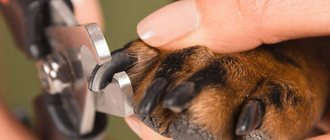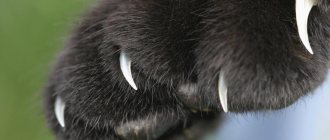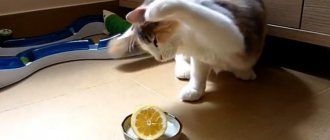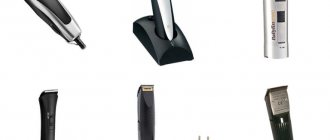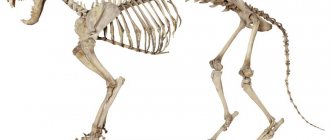In the article, we told you why it is necessary to trim your cat’s claws, how to prepare your pet, and what tools are needed. You will also learn how to trim nails correctly, how often and what complications may arise.
A caring housewife may wonder whether her cat's nails need to be trimmed. However, by that time all the furniture may have been chewed off for a long time, so study this issue in advance. In the article we told you whether they need to be cut? Who is not recommended to have a haircut? They also answered questions about what tools can be used to trim a cat’s claws and how to prepare for the first operation.
- What about my manicure?
Do I need to trim my cat's claws?
Claws are needed to climb trees, run and cling to surfaces. In wild animals they wear down on their own due to high activity. What about pets? Pets move much less, rarely walk outside the house and walk on soft surfaces. Our pets begin to damage the furniture and scratch everything. In addition, a cat's fifth claw is located on the back of the front paws just above the toes and never scratches against anything. In older individuals, it can even pierce the skin!
In most cases, nail trimming is not necessary. To determine whether your cat needs this operation, you should focus on the regrowth of the plate. The structure of all animals is individual, rely on the structure of your pet’s paws.
When should a kitten's claws be trimmed?
In what cases does a kitten need this procedure?
When does a kitten need to have its nails trimmed?
Overly frisky babies can scratch their mother's nipples when feeding. This is dangerous for the cat because she can get mastitis, so it is worth carrying out the procedure to protect the mother.
Examine the front paws to understand where to cut the kitten's claws. If they are devoid of pigment, then pink blood vessels can be seen underneath them, reaching almost to their tips. If the vessel does not reach the tip, then the claw is too long, so you can safely cut without fear of touching it.
As the claw grows, the vessel also lengthens. If you cut it to the same length next time, you may damage the vessel. You need to trim the claw so that it is a little longer than usual, and cut it again in a couple of weeks.
How to trim a cat's claws at home?
It must be said that this procedure is not one of those that should be carried out out of a sudden desire. A cat should be accustomed to trimming its claws as early as possible - as soon as it leaves childhood. And carry out regularly as the claws grow (once every two to four weeks). The young cat will quickly get used to the procedure, will not be nervous and will not cause trouble to the owner.
It is very advisable to purchase a special device - a nail clipper; it is both more convenient and safer to cut claws with it. Yes, any tool injures the claw plate, but the damage from a nail clipper is somewhat less.
During any grooming procedure, the cat feels in danger, as its movements are limited. Therefore, you should be understanding of attempts to escape, as well as scratching and biting. During the procedure, it is necessary to calm and persuade the pet, and after finishing the haircut, be sure to treat it with something tasty. Of course, you can’t scold him, much less beat him, “for bad behavior.”
Do not forget that the owner’s mood is always transmitted to the cat. Therefore, it makes sense to start this procedure in a good mood. And it is advisable to involve an assistant in this hectic event who will carefully but securely hold the cat. You need to hold it from behind.
It is very important not to damage the living base of the claw. It is perfectly visible in the light: the grown and insensitive part of the claw is transparent, and the living part is pink.
With your left hand you need to carefully take the cat's paw - so that the fingers spread apart. Using the thumb and index finger of the left hand, carefully extend the claw, and with the right hand, cut off the tip no more than 1-2 mm long. It’s better to be careful and cut off just a little bit rather than hurt the living base of the nail.
Firstly, the cat will bleed and there is a risk of infection. Therefore, during a haircut, you should always have an antiseptic on hand. Secondly, it is very painful - next time the pet will try with all its might to avoid the procedure.
You should not count on the fact that trimming nails will greatly reduce the damage caused to furniture and walls. The claws grow quite quickly, and scratching is an instinct. Therefore, it makes sense to purchase more scratching posts and place them in the most attractive places for the cat.
Didn't find what you were looking for? Use the site search form
What tools can you use to trim a cat's claws?
Trimming with nail scissors is a bad idea. People use them because the human nail plate is thin and flat. The structure of cat claws is different. The tool causes delamination. It is better to use nail clippers to trim animals.
Using this tool helps you trim your cat's nails painlessly. Externally, nail clippers resemble tweezers or pliers. There are 2 varieties: sickle-shaped and guillotine. Their choice is large, so each owner can choose the best option for him.
option.
Blisters are a tool that looks like nail scissors, but has blades curved at the ends.
Blister
Secateurs are equipped with a spring, which is located between the handles. It has a limiter, so you can only trim the outer length.
Guillotines – suitable for cats with thick nail plates. The tool looks like a cigar cutter. To cut a claw with it, you need to place it in a special hole at the end of the scissors. You need to move from bottom to top so as not to crush the claws. If your pet is still small, then it is better to carry out the procedure using pruners or a blister. It is dangerous to trim fragile claws with a guillotine.
Guillotine
When choosing a tool, you should focus on the type of structure of the nail plate. The main condition that must be observed is high-quality materials. It is better to spend money on buying a high quality nail clipper than to put your pet at risk. Before the procedure, the device must be treated with an alcohol solution to avoid infection.
You can also buy an electric trimmer. He sharpens his claws quickly, but the cat may be scared by the buzzing sound.
Electric trimmer
How to trim a cat's claws: what you need
photo from the site: sovetclub.ru
Can be used:
- Scissors are completely ordinary, but sharp enough that they can cut the stratum corneum.
- Nail clippers from a manicure set are the second option. Don't forget to keep them perpendicular. Otherwise, the plate may delaminate.
- Special trimmer - all veterinarians use it.
You will also need:
- Nail file - you will use it to grind off the sharp edge left after trimming.
- Cotton wool and hydrogen peroxide or chlorhexidine will come in handy if you accidentally injure your pet with wire cutters or scissors.
The main condition is that the tools should not be dull, and the blades should be thoroughly disinfected.
How to prepare a cat for the first procedure?
Preparing for the first procedure
It is difficult for adults to get used to various changes, so you need to get acquainted with the instrument from childhood. The nail clipper should become a familiar thing in the house for the animal. To do this, you need to let your pet smell the instrument and play with it so that it does not cause him fear.
When the pet is in a good mood, you need to take it in your arms and press on its fingertips. The pet will get used to it and in the future will not be afraid when its paws are touched.
Once your pet gets used to it, you can perform a simulated haircut.
The cat is placed in the owner's arms. They take his paws in their hands one by one. At first she may break out of your hands, but after the second or third time she will get used to it. Talk to your pet and distract him with something interesting, and after the procedure treat him with something tasty. This will ensure that the cat has a positive reaction. Carry out a few more of these “rehearsals”, and then you can start trimming the claws for real.
After the procedure, the pet is treated to food
There is no need to distract the cat from its business to carry out the procedure. And also you can’t hit or shout at her. However, it is worth being persistent. It is best to ask someone for help, so that one person holds the cat and the other does the haircut. If your pet is struggling violently, you can wrap him in a towel.
How to properly trim a cat's claws, what you need to have on hand and what you should know
If we answered positively to the question of whether it is possible to trim a cat’s claws, then now we should find out how these very claws are structured.
A cat's claw is a very complex system; the visible part is only its element. It consists of muscles, bones, joints, they provide movement. Thanks to them, cats can stick out and hide their claws from the pads. But before you start trimming, you need to know something else. Inside the claw itself there are nerves and vessels, they make up the pulp. The pulp occupies the main part of the claw and grows with it. The keratinized part that needs to be trimmed is only a couple of millimeters from the edge of the claw. This nuance should definitely be taken into account when learning the rules for trimming cat claws.
Before you begin the nail trimming procedure, you should prepare all the tools. You cannot use regular scissors, as they can damage the cat's claw because they are not adjusted to the shape of the claw. It is recommended to purchase special scissors in the store for trimming cat claws; they are also called nail clippers. They are quite a bit like regular ones, but their cutting surface is not very sharp and has a special shape, like a cat’s claw. A more expensive option is special tweezers; they are much more convenient to use, and the risk of injury is significantly reduced.
Step-by-step instructions - how to trim a cat's claws
Trimming a cat's claws
If you have finally decided to carry out the procedure, then step-by-step instructions on how to properly trim a cat’s claws will help you:
- Prepare the place. Take out the alcohol solution, napkins and cotton pads in advance in case of injury. Treat the nail clipper with an antiseptic and disinfect your hands to prevent infection.
- Make sure your cat is calm.
- Place her on your lap. It is advisable to wrap the cat in a towel so that it does not scratch you or jump out of your hands.
- Take the foot in your hands and fix it firmly. Expose the claws by applying gentle pressure to the pad.
- Decide where you will cut your hair. The cut line should be at the very edge of the claw, its white part, without pink nerve endings. The correct cut location is shown in the photo.
How to choose the right place to cut
- Bring the nail clipper to the paw and click it if the cat does not show concern. If she is scared, first calm the animal down and then try again.
- Trim the very edge of the claw at the correct angle: along the growth line, holding the scissors from bottom to top, so that the trimmed claw does not differ in shape from the untrimmed one. You need to cut off the very edge.
- To prevent your cat from associating nail trimming with something bad, feed her her favorite food.
To better understand the topic, watch an educational video on how to properly trim a cat’s claws at home.
How to cut your hair correctly?
It is important for the owner to know how to trim a cat’s claws without harming it.
The nail trimming procedure is absolutely painless and harmless.
Trimming cats' claws at home cannot be done with ordinary scissors intended for people, because they are not adapted to the structure of a cat's claw. Their use can lead to delamination and cracking of the claws.
The owner of a domestic cat must have a set of tools and materials for trimming his pet’s claws:
- nail clipper (scissors) for trimming cat claws;
- nippers for trimming peeled nails that cannot be picked up with scissors;
- nail file for processing sharp edges left after trimming;
- disinfectant solution to treat nail clippers and nippers;
- cotton pads;
- hydrogen peroxide (in case of bleeding).
The blades of scissors for trimming cat claws are made of stainless steel. They have a special shape that covers the claw. Tools must be sharp. Before the procedure, they must be treated with disinfectants.
The “manicure” begins after making sure that the cat is healthy, calm and relaxed (preferably after food or before bedtime). An animal that is frightened or excited by active games should not be subjected to this process. You can and should trim the claws of a domestic cat on the front and back legs. Cutting movements should be performed carefully, sharply and confidently.
nail clipper
Important! You can’t try it on for a long time or fiddle with cutting the claw. The more time spent on one finger, the more nervous the animal will be, and sensing the person’s uncertainty, the cat can completely disrupt the event.
Procedure for trimming cat claws:
- Prepare tools and materials. Clean scissors and hands with alcohol.
- Choose a well-lit place. Place the cat in a position that is comfortable for him and ensure his immobility. You should hold your pet gently, without much pressure, but firmly and confidently. During the ceremony, talk calmly and affectionately to the cat.
- Gently press your index finger and thumb onto the pad that is located under the claw. The cat will reflexively release the entire claw. The ability to extend and retract the claws is caused by the system of tendons, ligaments and muscles located in the phalanges of the cat's fingers. The claw is formed by keratinized epithelium, which contains blood vessels and nerve endings - the pulp.
Important! In claws that are not subject to pigmentation, the pulp is visually visible, highlighted in pink. You can easily see where it ends and can be trimmed. On dark claws it is difficult to discern the boundaries of the sensitive area. To avoid injuring your pet and to perform the procedure correctly, it is better to contact a veterinarian.
- Identify in the light the place where the pulp ends.
- Cut off the tip of the claw 2 mm above the pulp. It is important to hold the instrument strictly perpendicular to the surface being treated during the procedure. If the claw is accidentally injured and the cut touches the pulp, treat the wound with hydrogen peroxide.
- Use a nail file to round off the sharp edges where the cut is made , preventing delamination.
- Having treated one paw, you need to reward the animal for its patience with its favorite treat and proceed to the second paw. In this way, the animal will develop a positive attitude towards the event.
Procedure for trimming claws
You should remember about the fifth toe, which is located on the side surface of the paw, and also treat it as needed. An overgrown claw on it can dig into the pad, causing pain to the animal. Even free-roaming cats have trouble wearing it down.
You can trim a kitten's claws in the same way as an adult cat. The event is carried out in a playful way, without violence or causing physical discomfort to the baby. Before trimming the next claw, the baby is stroked, praised, and rewarded with a treat.
How often is nail trimming done?
The frequency of haircuts is individual for each cat. All animals have different activity levels, so you need to determine the frequency of trimming yourself. Active animals that often walk outside, run and climb trees practically do not need this procedure. Their claws wear down on their own.
If your pet doesn't go outside, its nails will wear down more slowly. In this case, a haircut needs to be done. For some, it is enough to trim once a month, for others – every 2-3 weeks.
Cats with low physical activity have their nails trimmed more often.
Color also affects the speed of growth. Light colored claws grow faster.
If your pet participates in exhibitions, you need to trim its nails every time before the event.
At what age does a kitten get used to grooming?
Many owners are interested in the question of at what age can kittens’ nails be trimmed. It is worth accustoming the animal to such procedures from the first months of life. Then, when the pet grows up, it will not be nervous and afraid at the sight of the wire cutters.
Sterilization of dogs: at what age is it better to do it?
The first time you can trim a kitten’s nails is at the age of 3-4 months. It is during this period that the claws begin to actively grow and interfere with the pet. One of the advantages of carrying out the procedure in childhood is that the baby will perceive all manipulations as a game and everything will go easily. And when he grows up, the procedure will already be familiar to him, which will avoid the animal’s aggressive reaction to what is happening.
Kittens' claws have not yet fully strengthened. The procedure will have to be carried out several times a month.
Reference! Before using instruments, it is recommended to wipe them with alcohol to maintain sterility.
The process of trimming a cat's claws
How to trim the nails of an aggressive cat?
Each cat has its own temperament. If your pet is calm and docile, you are very lucky. But there are aggressive and nervous individuals that you have to find an approach to. Most likely, the animal will claw, bite and break out of your hands. What to do if the cat doesn't give in?
Aggressive cat
You can't yell at a cat or hit it. Such behavior on the part of the owners will only frighten her, and she will subsequently avoid the procedure.
Take the cat in your arms, hug her, caress her. You should not make sudden movements so that she does not get scared. Be kind and gentle with your pet.
It is not recommended to trim your cat's claws alone. Ask a family member to help you. To prevent your cat from scratching or injuring you during the procedure, you can wrap it in a blanket or towel.
If the animal is very scared during grooming, the procedure should be rescheduled.
Possible complications after cutting nails
Complications after haircut
Cats are afraid of being groomed, so their behavior is often unpredictable. The pet may begin to break free from your hands and run away. There is a high probability of accidentally touching a nerve ending, and in this case blood may bleed. But there's no need to be nervous. It is important to react in time and provide first aid. There should always be disinfectants in the house. If there is a cut, you need to treat the paw with an antiseptic, anoint it with iodine and sprinkle it with talcum powder.
If the bleeding does not stop for a long time, contact your veterinarian.
What happens if you don't cut your hair on time?
If your pet's nails grow short, trimming is not necessary. They start to get in the way when they dig into the paw pads. You can notice this in their behavior. The animal will become slow, calm and inactive. In such cases, they often chew their paws, trying to remove the interfering claw.
If you notice that your cat is feeling uncomfortable, it's worth checking its paws. Long nails need to be cut using a nail clipper.
In advanced situations, you need to go to the veterinary clinic and consult with a veterinarian.
Trimming your cat's claws is easy! It is enough to have the necessary tools and disinfectants. It is better to do this in time than to put your pet in danger. Proceed carefully and carefully, and study the information about this procedure in detail.
Surgical method of removal
This method is only suitable for cats living at home. Even if you sometimes go to the country with your pet, and the cat is outside, surgical removal is not suitable for you. In case of danger, the cat will not be able to fend for itself. For cats and kittens that periodically spend time outdoors, it is important to be able to protect themselves from other animals and climb a tree.
The procedure is carried out only among young individuals. It takes time to get used to life without claws, and older animals have a hard time getting used to changes.
Surgical removal has contraindications, so it is worth finding out in advance whether your pet has chronic diseases.
Features of the structure of cat nails and rules for cutting them
After checking the tools, you can slowly begin processing. The first step is to properly “set up” the pet itself.
How to prepare a cat
You will have to “catch” the right moment: it is advisable that the cat be a little tired, sleepy, or at least calm when the haircut begins.
But you can’t interrupt his games and almost forcibly start cutting - the natural reaction will be rejection, and the animal simply won’t give in to your hands a second time.
Important! The most practical are tools with rubber lining on the handles. Your hand may slip off steel surfaces.
Wanting to avoid unnecessary injuries (both to themselves and to the cat), some owners swaddle their pets. This is also a good method that is used before trimming a cat’s claws at home.
This procedure will be unclear to the cat at first, and you should not expect him to immediately raise his claws. You will have to stroke the paws, slowly moving onto the pads, which lightly press down (until the claw appears). This simple method is especially useful for small kittens: they get used to it and there are no special difficulties with them.
At the very start you will have to calm and caress the animal. It’s also useful to talk - this kind of “explanatory work” also helps. Be patient, especially if you are dealing with an older cat.
Did you know? Trained cats can replace sniffer dogs. One of these professionals was Rusik, who in 2001–2003. helped find fish from poachers smuggling their catch through a police picket in Stepnovo.
Pruning rules
Before trimming a cat's claws, take a disinfected tool with clean hands.
Then proceed like this:
- The paw is held firmly, but gently. It should not twitch or slip out.
- Lightly press the center of the pad with two fingers so that the claw is fully exposed.
- Now a little anatomy. If you look closely in the light, you can see the free edge of the claw and the pink tissue inside it. This is a pulp with nerve endings and vessels, we do not touch it.
- The edge is removed so that at least 2 mm remains to the pulp. If the cat has dark claws, you have to act by touch, in 2-3 approaches, cutting off 1 mm each time.
- At the same time, scissors or a trimmer are held from above and perpendicular, trying to trim “in one fell swoop.” This is a matter of habit - after a few sessions it will be faster.
- At the end of the procedure, we adjust the edges to make it more comfortable for the cat to walk without clinging to its paws.
Due to inexperience, you can injure your paw. It’s unpleasant, but don’t panic—fill it with peroxide and calm the “patient.” The bleeding goes away quickly.
There seem to be no difficulties, but for the first time you will need the help of loved ones who will hold the cat.
Important! In some breeds, the pads become very overgrown and the hairs cover the claw. A clipper can help here (of course, if the animal is not afraid of it).
Don't forget to trim all the claws, 5 on the front legs and 4 on the back. Beginners often forget about this “asymmetry” and, without looking closely, leave an old claw in front, which over time causes discomfort to the animal.
Reward for good behavior
During the operation, do not forget to praise your pet, even if he becomes restless.
To smooth out the first stress a little, give him a vitamin, or even better, a treat you have prepared in advance (what your pet adores). This will slightly accustom the cat to the idea that a haircut is not so scary.
Find out what to do if you find your pet has problems such as ringworm or ear mites.
Covers for claws
Anti-scratch for cats
An alternative way is to purchase special covers. Anti-scratch caps are silicone caps made of soft plastic, which are attached using special glue. It is completely harmless and will not cause any discomfort to your pet.
The advantage of this method is that the cat will continue to scratch the furniture, but there will be no destruction. Besides, she won't be able to hurt her child.
Additional Tips
By taking your pet into your home, you have taken responsibility for its health. Timely trimming of claws is part of pet care. To keep your cat healthy, it is important to know the following rules:
- Monitor the condition of your paws. All pets are individual. To determine whether your pet needs nail trimming, you need to examine it periodically.
- Have iodine, antiseptic and zinc-based powder so that in case of a cut, disinfect the wound.
- Buy a nail clipper. These include pruners, blisters, guillotines and trimmers.
- Carry out the procedure if the pet feels safe.
- Talk to him while cutting his hair and distract him with something interesting.
- If you doubt your abilities, you should contact a veterinary clinic.
Treat your pets with tenderness and care so that they feel your love.
Why do cats have their claws trimmed?
Why do cats need claws? Claws are necessary for animals to survive, as they are a means of protection from offenders. With the help of its claws, a cat can climb a tree and get food for itself.
Claw trimming is recommended for cats that lead a sedentary lifestyle and do not leave the house. Outdoor animals wear down their nail plates while running and climbing trees, so they do not need this procedure. If your pet behaves aggressively towards people or damages furniture, a procedure is necessary. Trimming claws with special tools should also be done in the following cases:
- during the rehabilitation of an animal after surgery, because the cat is not able to grind down the nail plates itself;
- before bathing, medical manipulation, mating or preparing for an exhibition.
Fluffy couch potatoes need to have their claws trimmed to prevent them from growing into the soft tissue of their paws. The problem can cause inflammation, lameness and even an abscess. In addition, too long claws reduce the shock absorption of the body, which can lead to injury when jumping from a height.
Pets should be provided with a scratching post, but this item is not enough to maintain the health of the nail plate.

